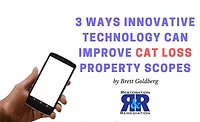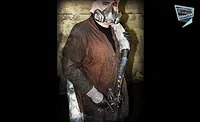Ensure Better Performance during Catastrophes
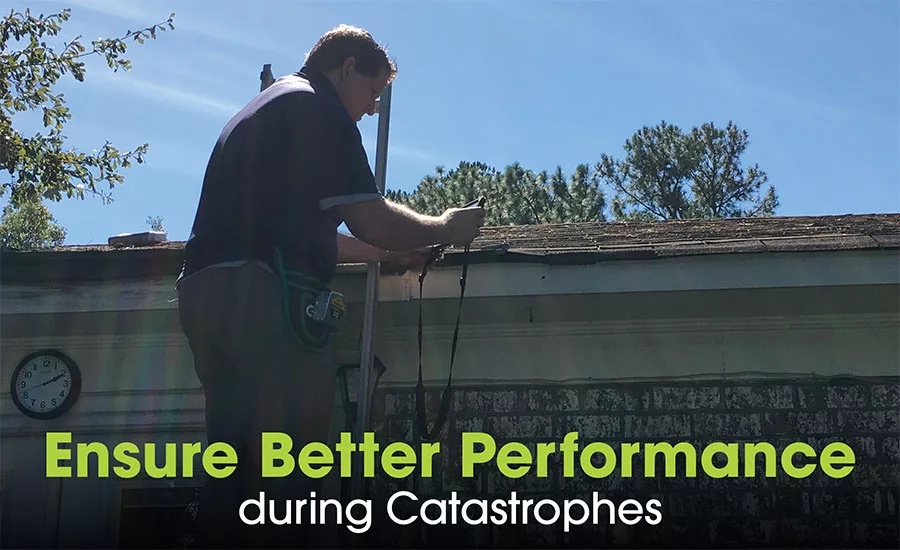
Photos courtesy of Spex
We all know catastrophe (CATs) events and other disaster response efforts challenge the industry more than other times of the year. We can look no further than the Fall of 2017 for a reminder about what a busy CAT season entails when rain, wind and fire created a near “biblical” and chaotic period for several months. According to NOAA, there were 16 disaster-related events in 2017 in the US that each exceeded $1B in total losses. Whether it’s a single tornado affecting a Midwest town or a series of hurricanes hitting the Gulf coast, CATs today require new and innovative approaches to teams, workflows and protocols. The result is greater volume and more moving pieces that require large teams to collaborate remotely. Regardless of the chaos, the expectations remain the same for most insurance carriers in regards to speed and efficiency during these tumultuous times. The best, modern solutions for handling CATs involve better collaboration, more accurate models and the utilization of data, documentation and analytics to work smarter. There are a variety of new technologies and solutions capable of achieving these goals and the industry is increasingly demanding an “up or out” mindset to handling CAT activity with more efficiency. If you can’t scale successfully for CATs, it casts doubt on a firm’s ability to handle business during the quieter times of the year.
Collaboration during CATs has been common in the industry for a while. Husband-wife adjusting teams have been dividing and conquering for years and Direct Response Programs (DRPs) have utilized inside-outside contractor models to effectively scope, estimate and repair damage during CATs. But, those traditional models have not identified the optimal solutions for dividing the work most reliably and effectively during a time of heightened activity. New models and technologies instead allow for better division of tasks and responsibilities and better overall documentation capture. The traditional husband-wife approach to field handling lacked a “real-time” element, meaning the person doing the scoping often needed to work a different schedule than the estimate writer to transfer data back and forth. With modern solutions that utilize live video or scoping technologies, field personnel can focus on inspecting, scoping and engaging customers while transferring that documentation back to an inside person on a real-time basis. During high-volume, challenging CAT periods, this improved collaboration can dramatically improve field productivity and reduce cycle times on claims. Further, it can make a huge difference to the actual work itself. No longer are contractors or adjusters required to inspect all day and write estimates all night. A new “assembly line” can occur to allow scoping and estimating to happen on a near real-time basis while creating a better overall documentation process.
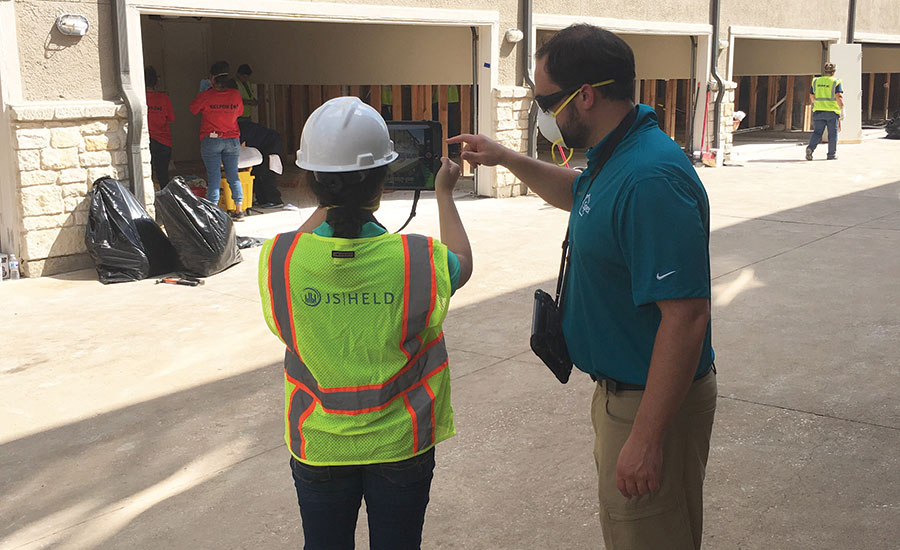
Photos courtesy of Spex
There is no greater killer to efficiency in our industry than inaccuracy. An inaccurate scope can lead to large estimating discrepancies, which can increase cycle times and put restoration or mitigation repair work at peril. Fortunately, the industry has started to utilize a bunch of new technologies and solutions that capture accurate scope details quickly and thoroughly the first time. There are many good solutions but we’ll highlight a few now that are used most commonly for diagrams, measurements and annotations:
Roofs: Eagleview and Xactimate (Geomni) remain the two most common solutions to effectively and accurately capture accurate roof details. Many contractors now look to Accurence too for roof information, especially in times of higher volume need.
Elevations: Spike is a compelling solution for elevation diagrams and measurements, especially in hard to reach locations. Spike is an easy-to-use laser measurement solution that adheres to the back of a mobile device. It provides measurement details with a high degree of accuracy from distant locations.
Floorplans: Bosch continues to stand-out as one of the best apps for capturing floorplan data and we all know floorplans matter a lot for estimate writing in Xactimate.
Overall: The industry continues to search for a “one size fits all” experience, especially in CAT environments when timing matters and network reliability is rarely available. Sketching by hand remains common while full 3D CAD features remain elusive, especially on tablet devices. We’ve explored Matterport and Structure as two options for that functionality. Overall, it’s exceedingly important to be able to archive the various measurement and diagramming information in a single platform such as Spex.
Better, more accurate inspections lead to error-free estimates and timely payments. Taking the time to capture more comprehensive, accurate field data can have exponentially better results down the road. Overall, speed shouldn’t be mistaken for faster inspections: a comprehensive inspection using the right digital tools can lead to fewer inspections or downstream problems with customers and financially.
The traditional “clipboard and graph paper” approach to scoping in CATs typically leaves service providers and carriers without the analytics and insights required during a time of heightened activity. Many in the industry describe the problematic “black box” effect that happens during CATs where scope notes, photos, videos, and any supplemental information is emailed around to the various collaborators, including brokers. Digital platforms like Spex that help evaluate performance and quality analytics are increasingly interesting to carriers and service providers. Are you focused on the right projects, people and processes? What is the specific status of any particular CAT file at a given moment? Without the correct data, it’s difficult to not be inundated in scattered paperwork and focus. That data not only helps manage less skilled field personnel, often a necessity during CATs, but can help ensure the right documentation is captured the first time and better collaboration can occur down the road.
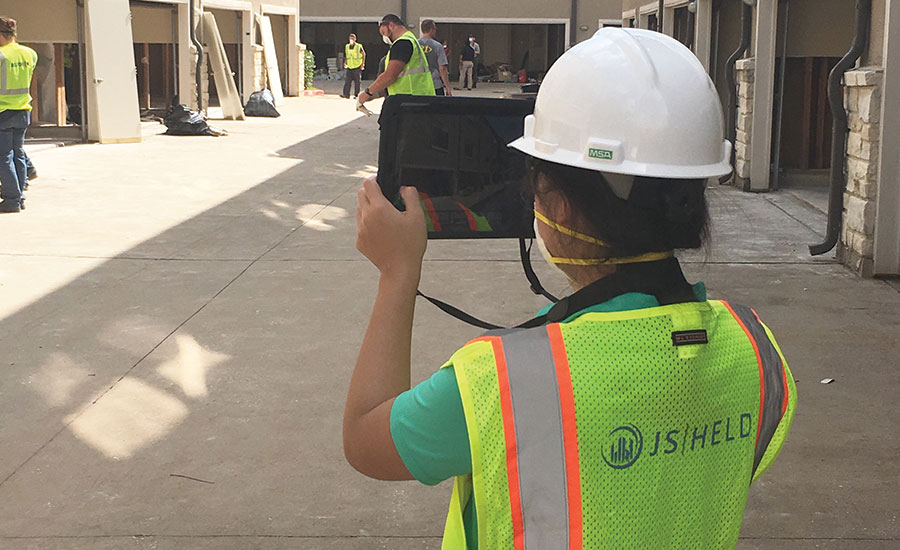
Photos courtesy of Spex
CATs are tough scenarios for lots of reasons. Losing site of the facts and rampant administrative inefficiencies can lead to waste and fraud. The carriers paying for restoration and mitigation work want better, faster with accurate results for resolving CAT claims. Within that goal is the requirement for better collaboration, better documentation and useful data that helps manage performance and quality.
New technologies and solutions exist to help your business handle CAT work in 2018. Is your business ready to take the leap forward?
Looking for a reprint of this article?
From high-res PDFs to custom plaques, order your copy today!



